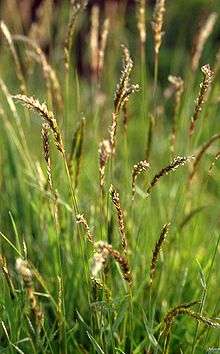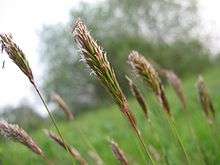Anthoxanthum odoratum
Anthoxanthum odoratum, known as sweet vernal grass, is a short-lived perennial grass that is native to acidic grassland in Eurasia and northern Africa.[1] It is grown as a lawn grass and a house plant, due to its sweet scent, and can also be found on unimproved pastures and meadows. The specific epithet odoratum is Latin for 'odorous'.
| Anthoxanthum odoratum | |
|---|---|
 | |
| Scientific classification | |
| Kingdom: | Plantae |
| Clade: | Tracheophytes |
| Clade: | Angiosperms |
| Clade: | Monocots |
| Clade: | Commelinids |
| Order: | Poales |
| Family: | Poaceae |
| Subfamily: | Pooideae |
| Genus: | Anthoxanthum |
| Species: | A. odoratum |
| Binomial name | |
| Anthoxanthum odoratum | |
Description
Anthoxanthum odaoratum grass grows in tufts with stems 25–40 cm (9.8–15.7 in) tall, and short, broad green leaves 3–5 mm (0.12–0.20 in) wide, which are slightly hairy. It flowers from April until June, i.e. quite early in the season, with flower spikes of 4–6 centimetres (1.6–2.4 in) long and crowded spikelets of 6–10 mm (0.24–0.39 in), oblong shaped, which can be quite dark when young. The lower lemmas have projecting awns. The ligules are quite long, up to 5 mm (0.20 in), blunt, with hairy fringes around the side.
The scent is particularly strong when dried, and is due to coumarin, a glycoside, and benzoic acid – it smells like fresh hay with a hint of vanilla. The seed head is bright yellow in color.[2]
Anthoxanthum odoratum is experiencing speciation parapatrically in areas of mine contamination.[3][4]
Cultivation
It is grown by scattering seed on tilled ground in the spring through fall, germinating in 4 to 5 days. It prefers sandy loam and acidic conditions (a low pH). As an agricultural grass it has a low yield, but can grow on land too acidic for other grasses.
Gallery
References
- http://www.plantsoftheworldonline.org/taxon/urn:lsid:ipni.org:names:389034-1
- BSBI Description Archived 2011-07-17 at the Wayback Machine retrieved 10 December 2010.
- "Parapatric speciation". University of California Berkeley. Retrieved 3 April 2017.
- Janis Antonovics (2006), "Evolution in closely adjacent plant populations X: long-term persistence of prereproductive isolation at a mine boundary", Heredity, 97 (1): 33–37, doi:10.1038/sj.hdy.6800835, PMID 16639420
Further reading
- Pink, A. (2004). Gardening for the Million. Project Gutenberg Literary Archive Foundation.
External links
| Wikisource has the text of the 1905 New International Encyclopedia article Vernal Grass. |

_clean%2C_no-description.jpg)







